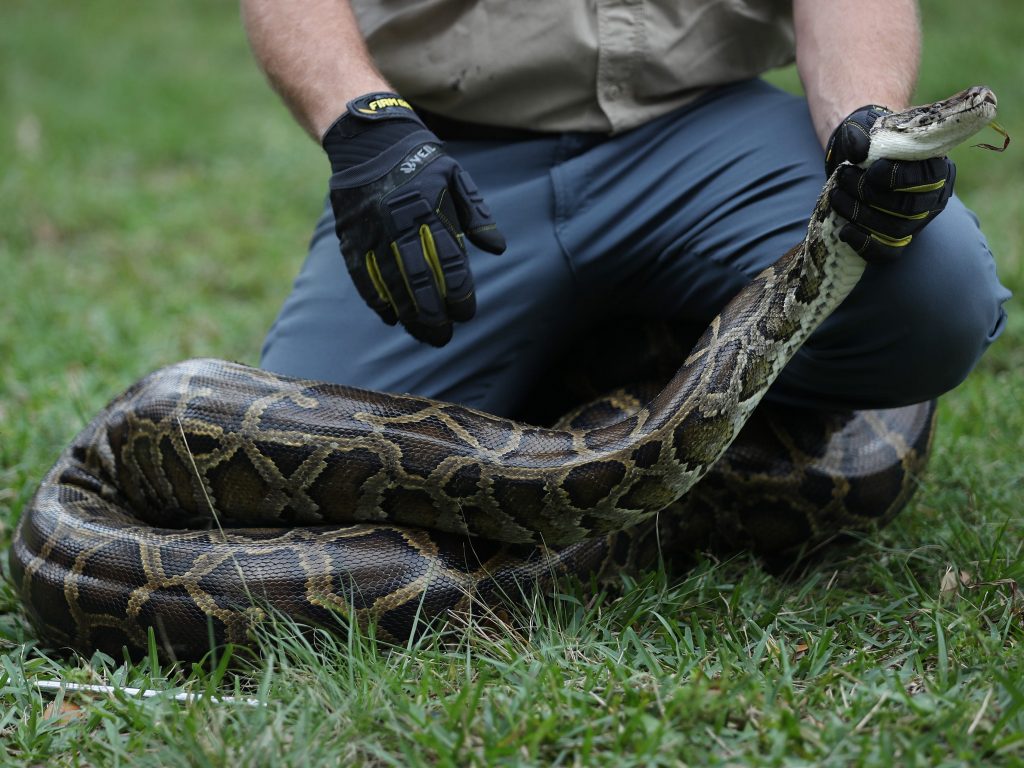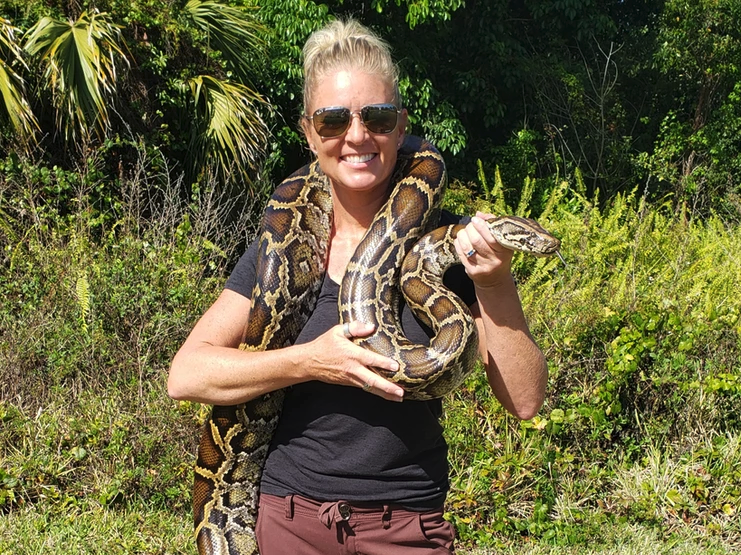- Invasive Burmese pythons have decimated native species in Florida.
- The state pays 100 contractors to hunt the pythons, which are cryptic and hard to locate.
- "It's not the pythons' fault that they're here, but they do have to go," one python hunter said.
Amy Siewe has always loved snakes. When she was a kid, her dad would take her down to the creek and they'd try to catch reptiles, amphibians — all kinds of little critters.
But in early 2019, she tagged along on a different kind of hunt. Siewe heard hunters in South Florida were being paid to catch giant Burmese pythons, so she flew from her home in Indiana — where she ran a successful real-estate business — to join them and see the hunt for herself.
"We caught a python, and I was hooked," Siewe told Insider. "I was like, 'This is what I'm supposed to be doing. I don't know how. I don't know why. But this is it.'"
She went back to Indiana and within two months dropped everything, closed her business, and moved to Florida to hunt pythons.
The invasive pythons are feasting on native species
Siewe is one of 100 licensed hunters contracted by Florida to catch and kill the invasive reptiles, which have wreaked havoc on the ecosystem and decimated native species.
"They are eating our native wildlife," Mike Kirkland, an invasive-species biologist who manages the South Florida Water Management District's python-elimination program, told Insider. "They're also outcompeting native animals for food."
In the Everglades National Park and other areas in South Florida, there's been a 90% to 95% reduction of native animals, Kirkland explained.
One of the largest of all snakes, pythons can grow up to 20 feet long and feast on animals as large as white-tailed deer. A study published in 2012 linked sharp declines in multiple native species to the snakes. Researchers found populations of raccoons, opossums, and bobcats had dropped 99.3, 98.9, and 87.5% respectively since 1997. Other species like marsh rabbits, cottontail rabbits, and foxes "effectively disappeared."
The Everglades used to be teeming with such wildlife. "Now, you're challenged to find a single mammal when you go there," Kirkland said.
First detected in the wild in Florida in the late 1970s, the pythons didn't become a noticeable problem until the '90s. They most likely ended up in the wild in Florida as a result of the exotic-animal trade. Owning, breeding, and selling the snakes was permitted under certain conditions until wildlife officials enacted an outright ban in 2021. But pet owners may have let snakes loose when they got too big. There are also unconfirmed accounts of pythons escaping breeding facilities destroyed by storms.

Whether directly or indirectly set loose, the pythons have since thrived in the state, thanks to a lack of predators and a subtropical climate that resembles their native lands of Southeast Asia.
However, officials have no real sense how many of the snakes are in the state because they tend to live in relatively inaccessible places, like the Everglades wetlands, and can be difficult to detect.
"They're very cryptic animals. They're very well camouflaged," Kirkland said. "You could be right up on a python and it blends in so well to its environment, if you don't know what you're looking for, chances are it's going to walk right past."
By some estimates, there may be 150,000 pythons in Florida, but Kirkland said it's difficult to cite even a ballpark figure: "The truth is we just don't know."
Paid to hunt — in the name of conservation
Wildlife officials are working on projects to estimate the python population, but the most successful effort to address the problem has been the python hunters, Kirkland said.
He launched the South Florida Water Management District's python-elimination program in 2017 and oversees 50 hunters, including Siewe. Along with the Florida Fish and Wildlife Conservation Commission's sister program, the state has 100 paid contractors.
The SFWMD hunters are paid $10 to $15 an hour, depending on the area they are hunting, for up to 10 hours a day. They're also paid $50 for each python they catch, up to the first 4 feet. Any python longer than that nets the hunter $25 for each additional foot.
The state uses an app that allows wildlife officials to track the hunters in real time. Kirkland said he uses his phone to monitor the hunters' locations as they move around the Everglades, helping him optimize the project area and respond if anyone's in trouble. The system also allows for electronic data collection and analytics.
"I sleep maybe every other night," Kirkland said, adding the program has largely consumed him since its launch more than five years ago. "I'm either out in the field with the hunters myself or I'm at home tracking them."
Together the programs have removed nearly 10,000 Burmese pythons from Florida's ecosystem.
Once a year, the state even hosts a Python Challenge, where hunters come from all over the US to compete to catch the most pythons and win a $10,000 prize. Primarily an outreach event, the challenge has helped raise awareness about Florida's python problem and garnered support for the conservation efforts.
Despite the challenges, Kirkland said that between the elimination programs and other management strategies, he's confident the state will see a decline in the python population and an increase in native species.
The 'easiest' way to catch a python? With your hands
In the meantime, the state relies on contractors like Siewe, who said hunting the pythons was a constant effort of trial and error. The pythons are well hidden, often in inaccessible places, and spend the vast majority of their time not moving.
She said she goes out five to six nights a week and usually catches a python on three to four of those nights. The hunters have to be patient and wait for pythons to show themselves.
"If we just start walking through the swamp or the woods, or wherever, you'll never find them," Siewe said.

She goes out at night, when the pythons are active, either alone, with another hunter, or with a state-approved assistant. They drive slowly down roads and levees with their lights, searching for a python. Sometimes they'll spot one on the side of the road, or in shallow water, or even crossing the road.
Once it's spotted — and someone shouts "python!" — they stop the vehicle, get out, and approach. They don't kill the pythons on the spot, instead capturing the snakes, preferably by grabbing them behind the head to avoid a razor-sharp bite.
"I know it sounds crazy, but it is the easiest way to catch these pythons," Siewe said, adding she's been bit many times. Though it's painful, the snakes aren't venomous.
She said that as apex predators, pythons don't get spooked and instead stay mostly still.
"And then you grab them and of course they freak out," she said. "But for the most part you can walk right up to them." After removal from the environment, the snakes are killed. Siewe said she brings them home to be euthanized.
Siewe loves what she does but says it's "unfortunate" that the snakes have to be killed. Because of that, she's also made it her mission to use as much of the snake as possible. She makes and sells snakeskin products — like key chains and Apple Watch bands — exclusively from the invasive pythons.
Nearly all the python hunters love snakes the way that Siewe does, she said, which makes them good at what they do: "We're good because we're not afraid, we know a lot about them, and we want to learn more and more about them. The thing that is very difficult is that we have to kill them."
"For every python we're taking out of the Everglades, it's saving the lives of hundreds of our native species," she said. "It's not the pythons' fault that they're here, but they do have to go."
Have a news tip? Contact this reporter at [email protected].

